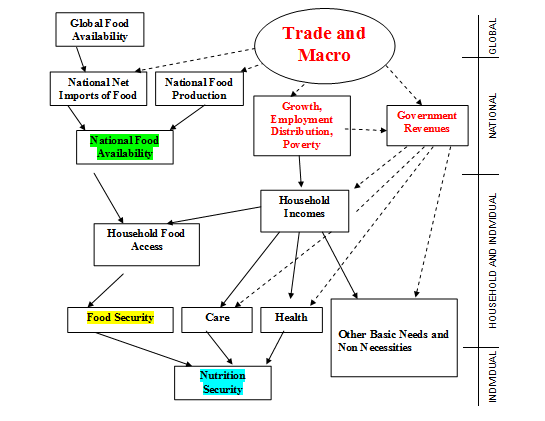
Food security is an incredibly complex, multi-faceted concept, and so any discussion must first start from a common definition, such as the one adopted at the World Food Summit in 1996: “Food security exists when all people, at all times, have physical and economic access to sufficient, safe and nutritious food that meets their dietary needs and food preferences for an active and healthy life”. Since that summit, it has been widely acknowledged that food security consists of four main components: 1) availability (which depends on domestic supply, stocks, and trade); 2) access (which is influenced by income, employment, and poverty patterns related to economic growth and development); 3) utilization (which depends on food quality, as well as health services, water and sanitation infrastructure, education, and female empowerment, among other things); and 4) stability (which requires that physical and economic access and proper utilization are able to take place at all times).
This chart (adapted from Smith, 1998 ) shows the different channels through which trade (and other macroeconomic factors) can influence food security. Domestic production and imports determine domestic , or national, availability (component 1 of our definition). Economic growth that generates inclusive employment and income opportunities is crucial for access to food (component 2). Government revenues can be used to implement policies and investments supporting several different aspects of food security, such as agricultural R&D (components 1 and 4) and basic health services and water and sanitation systems (component 3). What counts most for development in the end, though, is all of these policies’ impacts at the individual level (labeled “nutrition security”, which is somewhat different from “food security”).
When discussing the impact of trade on food security, it is important to consider these multiple channels. It is also necessary to separate “trade,” “trade policies,” and “WTO disciplines,” which are all different issues to be discussed in more detail in future posts.
First, trade and trade policies influence global food availability, as well as production and food imports (including food aid) at the national level. These latter two aspects define national food availability, an important component of the notion of food security. Research has shown food availability to have a positive correlation with declines in malnutrition.
Second, trade and trade policies affect both producers’ profits and consumers’ costs, mainly, but not only, through their effect on food prices, both global and domestic. By influencing incentives for producers, trade and trade policies also have an impact on farmers’ and countries’ decisions to invest in agriculture and to adopt new technologies, generating dynamic long-term effects that are usually more important than the short-term impacts of any one policy. Trade and trade policies also affect the cost of food, with important consequences for wages and the maintenance and accumulation of human capital, which also generate medium-term effects on welfare and production.
Third, trade and trade policies may also have an impact on the level and stability of economic growth, as well as on that growth’s employment generation, income distribution patterns, and poverty effects. These variables determine income levels and variability, and thus determine whether or not economic growth supports poor populations.
Fourth, government revenues, through the collection of trade taxes and through the impact of the rate and variability of growth on general tax collection, are also impacted by trade and trade policies. The level of government revenues collected affects 1) investment in technology, services, and infrastructure that support food and agricultural production; 2) implementation of transfer policies (like food subsidies, conditional cash transfers, or other social safety net programs); and 3) the financing of public services and investments in health, education, and related areas. Furthermore, external obligations related to trade and agricultural policies (which are influenced by WTO agreements) or to international financial institutions (which are influenced by loan conditionality) may also affect how government revenues can be used. All of these variables are crucial to understand for both food and nutrition security.
Finally, trade policies may lead to lower or higher volatility in production, stocks, and prices at the world and/or national levels for different commodities and markets.
These multiple channels through which trade can impact food security have implications for the FAO’s definition of food security. Physical access to food (or food availability) is influenced by the first, second, and fourth channels, all of which help determine the volume of domestic production, stocks, imports, and food aid; economic access to food depends on the relation between the cost of food (second channel), households’ incomes (third channel), and potential food subsidies (fourth channel). The definition of food security also calls for physical and economic access to be available “at all times;” therefore, the fifth and final channel considers the possibility that trade and trade policies may help or harm the global and domestic stability of food availability, food prices, and household incomes. Finally, nutrition security may be affected by the fourth channel, which is linked to the use of government revenues to provide subsidies, services, and investments for poor and vulnerable populations.
In summary, trade can have a variety of impacts on the determinants of food and nutrition security, such as food availability, incomes and employment, food costs, government transfers and subsidies, and public services and investments. Given these wide-ranging influences, it is difficult to identify unequivocally the impact, whether positive or negative, of a specific trade policy. This complicated framework must be kept in mind during the WTO negotiations, and the various channels will be further discussed in future posts.
References
1. Smith, L.C. 1998. “Can FAO's Measure of Chronic Undernourishment Be Strengthened?” Food Policy 23(5): 425-445.
Files:

